丁往道英语写作手册
英语基础写作1授课教案
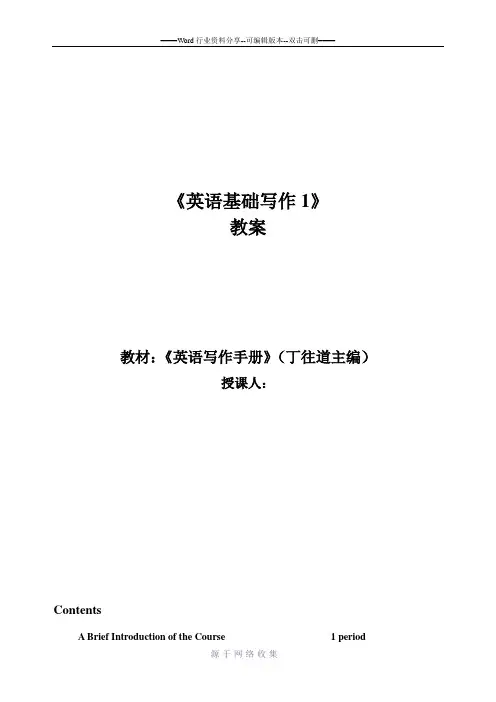
Chapter Four Composing Essays
ChapterFiveManuscript Form and Punctuation4periods
ChapterSixPracticalWriting(1)2 periods
2.1 What is writing
The dictionary defines writing as “relating or communicating by forming symbols on a surface with a pen, pencil, or other tools.” The key words here are relating and communicating. Written ideas are usually meant to pass on a message.
《英语基础写作1》
教案
教材:《英语写作手册》(丁往道主编)
授课人:
Contents
A BriefIntroduction of the Course1 period
Chapter One Using Proper Words5 periods
Chapter Two Making Correct and Effective Sentences6 periods
2.Being clear: don’t puzzle your readers.
3.Being brief: don’t waste your reader’s time.
4.Seeking variety: to vary sentence length; to work on liveliness.
丁往道《英语写作手册(中文版)》考研真题详解(命题作文)【圣才出品】
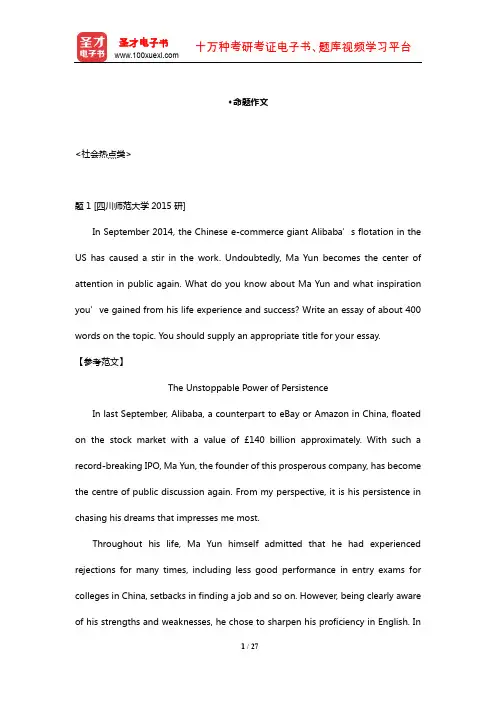
◆命题作文<社会热点类>题1 [四川师范大学2015研]In September 2014, the Chinese e-commerce giant Alibaba’s flotation in the US has caused a stir in the work. Undoubtedly, Ma Yun becomes the center of attention in public again. What do you know about Ma Yun and what inspiration you’ve gained from his life ex perience and success? Write an essay of about 400 words on the topic. You should supply an appropriate title for your essay.【参考范文】The Unstoppable Power of PersistenceIn last September, Alibaba, a counterpart to eBay or Amazon in China, floated on the stock market with a value of £140 billion approximately. With such a record-breaking IPO, Ma Yun, the founder of this prosperous company, has become the centre of public discussion again. From my perspective, it is his persistence in chasing his dreams that impresses me most.Throughout his life, Ma Yun himself admitted that he had experienced rejections for many times, including less good performance in entry exams for colleges in China, setbacks in finding a job and so on. However, being clearly aware of his strengths and weaknesses, he chose to sharpen his proficiency in English. Inspite of the limited resources and less ideal environment for learning English, he managed to practice his oral English as well as broaden his horizons by giving foreign tourists free guide every morning in his hometown Hangzhou. And this experience lasting for nine years proved to be conducive to both the improvement in his languages abilities and the formation of a brand new world view.While working as a translator for a US trading company, Ma Yun decided to start his own online business in China, aiming to build a large Internet market to connect consumers and companies from different regions or countries. And that is how Alibaba began. At the beginning, there were only fifteen employees in 1999. But by now, this Chinese e-commerce giant has, according to Ma Yun, directly or indirectly created 40 million jobs in China. And its founder plans to expand market abroad. Nevertheless, the transformation from a startup to a listed company with the largest initial public offering in history, did not proceed smoothly. If he had not manages to attracted investment in 2000, Alibaba could have failed like many other Internet companies did at that time. What’s more, rumors or doubts have never completely disappeared, whether it was at the early stage or at the prosperous period of Alibaba. As for Ma Yun, scarcely does he allow these noises to overwhelm his inner voices. It’s his persistence and commitment that make his dreams come true in the end.To sum up, just as the old saying goes, constant dropping wears the stone. As long as we pursuit our dreams like what Ma Yun does, nothing could stop us from realizing them, since persistence not only gives us the hope to hold on to ourdreams, but also enables us to fight against obstacles all along.【范文点评】题目要求围绕阿里巴巴在美国成功上市这一事件,谈谈作为中国互联网巨头传奇人物马云,他的经历给了你怎样的启发,撰写一篇约400词左右的文章。
北外等32所高校翻译硕士考研的官方指定参考书目
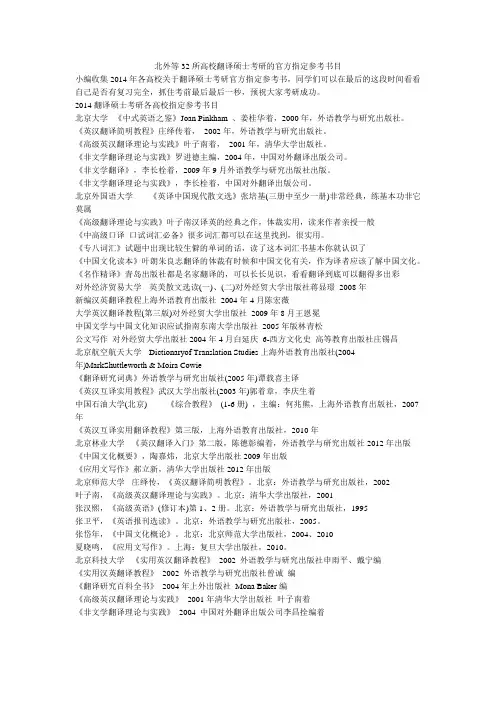
北外等32所高校翻译硕士考研的官方指定参考书目小编收集2014年各高校关于翻译硕士考研官方指定参考书,同学们可以在最后的这段时间看看自己是否有复习完全,抓住考前最后最后一秒,预祝大家考研成功。
2014翻译硕士考研各高校指定参考书目北京大学《中式英语之鉴》Joan Pinkham 、姜桂华着,2000年,外语教学与研究出版社。
《英汉翻译简明教程》庄绎传着,2002年,外语教学与研究出版社。
《高级英汉翻译理论与实践》叶子南着,2001年,清华大学出版社。
《非文学翻译理论与实践》罗进德主编,2004年,中国对外翻译出版公司。
《非文学翻译》,李长栓着,2009年9月外语教学与研究出版社出版。
《非文学翻译理论与实践》,李长栓着,中国对外翻译出版公司。
北京外国语大学《英译中国现代散文选》张培基(三册中至少一册)非常经典,练基本功非它莫属《高级翻译理论与实践》叶子南汉译英的经典之作,体裁实用,读来作者亲授一般《中高级口译口试词汇必备》很多词汇都可以在这里找到,很实用。
《专八词汇》试题中出现比较生僻的单词的话,读了这本词汇书基本你就认识了《中国文化读本》叶朗朱良志翻译的体裁有时候和中国文化有关,作为译者应该了解中国文化。
《名作精译》青岛出版社都是名家翻译的,可以长长见识,看看翻译到底可以翻得多出彩对外经济贸易大学英美散文选读(一)、(二)对外经贸大学出版社蒋显璟2008年新编汉英翻译教程上海外语教育出版社2004年4月陈宏薇大学英汉翻译教程(第三版)对外经贸大学出版社2009年8月王恩冕中国文学与中国文化知识应试指南东南大学出版社2005年版林青松公文写作对外经贸大学出版社2004年4月白延庆6-西方文化史高等教育出版社庄锡昌北京航空航天大学Dictionaryof Translation Studies上海外语教育出版社(2004年)MarkShuttleworth & Moira Cowie《翻译研究词典》外语教学与研究出版社(2005年)谭载喜主译《英汉互译实用教程》武汉大学出版社(2003年)郭着章,李庆生着中国石油大学(北京) 《综合教程》(1-6册) ,主编:何兆熊,上海外语教育出版社,2007年《英汉互译实用翻译教程》第三版,上海外语教育出版社,2010年北京林业大学《英汉翻译入门》第二版,陈德彰编着,外语教学与研究出版社2012年出版《中国文化概要》,陶嘉炜,北京大学出版社2009年出版《应用文写作》郝立新,清华大学出版社2012年出版北京师范大学庄绎传,《英汉翻译简明教程》。
Unit 1 Face to Face with Hurricane Camille
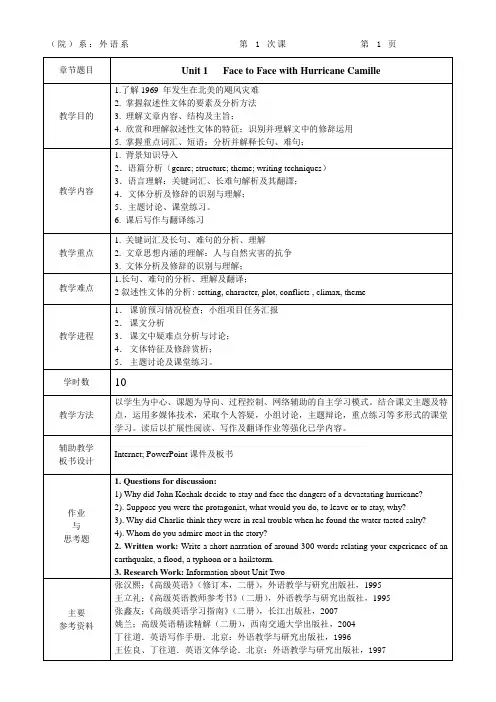
板书设计
Internet;PowerPoint课件及板书
作业
与
思考题
1. Questions for discussion:
1.Why did John Koshak decide to stay and face the dangers of devastating hurricane? Suppose you were the protagonist, what would you do, to leave or to stay, why?
5.掌握重点词汇、短语;分析并解释长句、难句;
教学内容
1.背景知识导入
2.语篇分析(genre; structure; theme; writing techniques)
3.语言理解:关键词汇、长难句解析及其翻譯;
4.文体分析及修辞的识别与理解;
5.主题讨论、课堂练习。
6.课后写作与翻译练习
教学重点
4). Whom do you admire most in the story?
2. Written work:Write a short narration of around 300 words relating your experience of an earthquake, a flood, a typhoon or a hailstorm.
4. To comprehend the difficult sentences by paraphrasing, interpreting and translating
教学内容
1.Reviewing the key points in Para.1-6.
2. Detailed study ofPart II (Para7-27)
丁往道英语写作手册
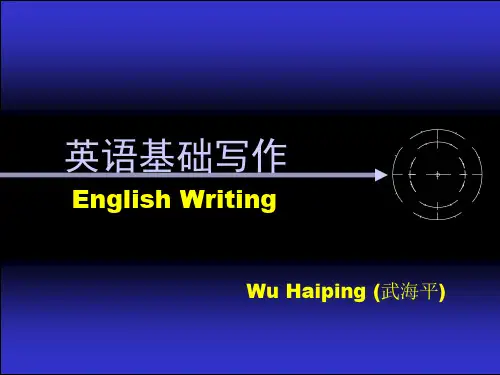
Part1 Manuscript Form 文稿格式
1 Arrangement 安排 2 Capitalization 大写 3 Word Division 移行 4 Punctuation 标点 5 Handwriting 书法
What is a good manuscript form?
writing the title 写标题 leaving margins 纸边留空 indenting 段落开端缩进 capitalizing 大写 dividing words 词的移行
1 Arrangement 安排
About titles关于题目
P 35 Ⅱ. Type of Sentences 句子类型
(use)
1. Declarative, interrogative, imperative, and exclamatory sentences 陈述句、疑问句、祈使句和感叹句
1. declarative sentence 陈述句 She is my fiance.
P35 Ⅱ. Type of Sentences 句子类型
(structure)
2 .simple, compound, complex, or compound-complex sentences 简单句、并列句、复合句或并列复 合句
simple sentence 简单句
It has one subject and one predicate verb. To see is to believe.
丁往道《英语写作手册(中文版)》复习笔记(造句)【圣才出品】
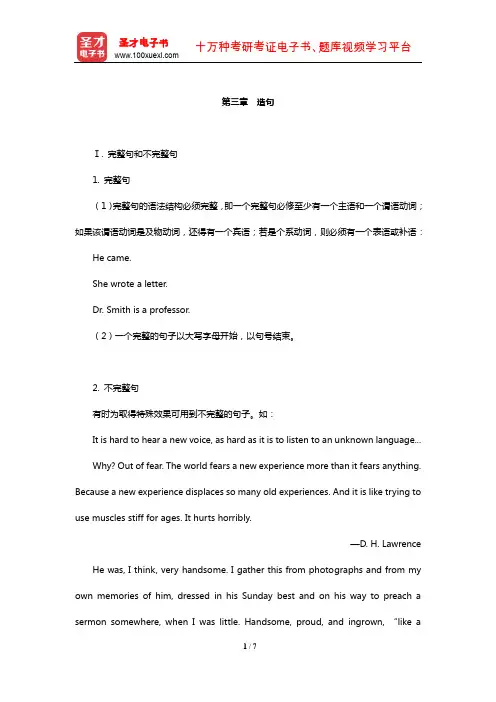
第三章造句Ⅰ. 完整句和不完整句1. 完整句(1)完整句的语法结构必须完整,即一个完整句必修至少有一个主语和一个谓语动词;如果该谓语动词是及物动词,还得有一个宾语;若是个系动词,则必须有一个表语或补语:He came.She wrote a letter.Dr. Smith is a professor.(2)一个完整的句子以大写字母开始,以句号结束。
2. 不完整句有时为取得特殊效果可用到不完整的句子。
如:It is hard to hear a new voice, as hard as it is to listen to an unknown language...Why? Out of fear. The world fears a new experience more than it fears anything. Because a new experience displaces so many old experiences. And it is like trying to use muscles stiff for ages. It hurts horribly.—D. H. Lawrence He was, I think, very handsome. I gather this from photographs and from my own memories of him, dressed in his Sunday best and on his way to preach a sermon somewhere, when I was little. Handsome, proud, and ingrown, “like atoe-nail,” somebody said.—James Baldwin 在上面第一篇中有三个不完整的句子(“why?”“Out of fear.”以及“Because a new experience...”),在第二篇中有一个(“Handsome,proud”)。
北外丁往道《英语写作手册》教案
延安大学西安创新学院外语系课程教案课程名称:英语写作主导教材:《英语写作教程》所属教研室:大学英语第二教研室课程讲授人:李蓉适用年级:英语专业14级授课时间:第2周—第18周2015—2016学年第一学期课程教案课程教案课程教案课程教案课程教案课程教案课程教案课程教案延安大学西安创新学院外语系课程教案课程教案课程教案课程教案1.1 Common features of good writing1. To express a clear point means to convey the writer's main idea or--in the case of descriptivewriting--the significance of the object, place or person described; in other words, an attentive reader should be able to grasp the writer's purpose.2. To be tightly structured, writing should contain logical or associative connections and transitions which clearly express the relationship of the ideas described.3. To be grammatically and syntactically correct, writing should adhere to the rules of Standard American English, including proper punctuation and spelling. If writers choose to use unconventional syntax, they should be able to justify their choices.1.2Cultural differences in writing1. Different ways of thinking2. Different ways of analysis3. Concrete thinking and abstract thinking4. Different valuesValues on space-timeValues on human behaviorsValues on social relationships1.3English writing VS. Chinese writing1.Chinese writers tend to be ―indirect‖, while Anglo-Americans are found to be more ―direct‖.2.English and Chinese writing differ in sentences and word variety.3.English is found to use more connectives than Chinese, both between clauses or sentences andbetween paragraphs.1.4Strategies in learning English writing1. From the beginning, you have to learn how to write an English essay.2. English writing tends to be more ―rigid‖ than Chinese writing.3. Remember that reading helps to learn how to write.4. Writing is also learned through writing.1.5 Homework1. Go over the following paragraphs, one in English and the other in Chinese, and decide which sentence in each paragraph express the author’s main idea. Write your answers on the space provided.2. What do you think translation form a preconceived Chinese version needs to be avoided when we are writing in English? Discuss with your partners and then list at least three reasons on the space provided.课程教案Part T wo Diction2.1Levels of words ----Three levels⑪Formal words: Also learned words, literary words or ―big‖ words, containing three or more than three syllables, seldom used in daily conversation, e.g. enough-sufficient; deal with-handle.⑫common words: Most of the words people use every day and appear in any types of writing, e.g. question, brother.⑬informal words: Mainly used in informal or colloquial words, short and seldom appear in formal writing, such as guy-man, puppy, daddy, slang.2.2 General and specific wordsComparatively speaking, some words are more general or more specific in meaning than other words. P rofessionals, for instance, is more general than scientists, doctors, teachers, lawyers, journalists, etc, all of which are more specific. But scientists may be called a general word then compared with physicists or chemists, which, in turn, is more general than biochemists.Specific words help to make the writing clear, vivid, exact, colorful and attractive; they can make the readers see, hear or feel what the writer wants to describe; they can provide more details and information, the writing will be effective and impressive. More examples:A good man----kind, honest, generous, warm-hearted, brave, selfless, etc.Good food----delicious, tasty, nourishing, wholesome, fresh, rich, etc.House----mansion, villa, cottage, cabin, hut, shed(棚屋,小屋),etc.Laugh----smile, grin, giggle, chuckle(嗤的一声笑,低声笑),etc.2.3 Rules to choose words in writing an essay (or a formal writing)⑪Sentences tend to be longer and more complex. E.g. see text book P30⑫Limit your use of subjective pronouns, often using ―it‖ or passive voice. E.g. see P31⑬A void using informal or colloquial words. E.g. take in—deceive; go back—return; a lot—several/many/much/a large amount/number of; let—allow/permit; fellow—person; kind of—somewhat; like—as if/appear.⑭A void using general words, using more specific words. E.g. good, bad great, interesting, very, really, too, etc, are general. (informal) Mary is an interesting person.----Mary is humorous and intelligent.(formal)⑮A void contractions(缩写)and abbreviations(缩略词): don’t—do not; we’ll—we will; can’t—can not; TV—television;i.e.—that is; ad—advertisement.⑯Do not start a sentence with a coordinating conjunctions, but a subordinating conjunction can serve the purpose.E.g. He is usually easy-going. But—however before his first cup of tea, he is a bear.2.4 Figures of speech1. Simile: a comparison between two distinctly different things and the compassion is indicated by the word ―as‖ or ―like‖.E.g. My love is lie a red rose.The old man’s hair is as white as snow.2. Metaphor: also a comparison of similarities between two different things, but the comparison is implied, not expressed by ―as‖ or ―like‖.E.g. My love is a red rose. He is the soul of the team.The life of poor people was carved so sharply in his heart that he could never forget it.3.Personification: to treat a thing or an idea as if it were human or had human qualities.E.g. this time fate was smiling to him. Dust came silently.4. Metonymy(借喻): using the name of one thing to refer to another thing which is closely related.E.g. When the war was over, he laid down the sword and took up the pen.His purse would not allow him to buy that car.5.Irony(反语): the use of words which are clearly opposite to what is meant, to achieve a special effect.E.g. Y ou come so early, I have waited for more than an hour!6. Overstatement and understatement(含蓄表达、保守说法、低调):to exaggerate and play down respectivelyE.g. She is dying to know what job has been given her.It took a few dollars to build this indoor swimming pool.7. Alliteration(头韵): the appearance of the same initial sound in two or more words.E.g. He is as proud as a peacock.We are fighting for our health and home.2.5 Homework1.In each sentence, choose the more precise of the two in italics;2.Identify the sentences as formal, less formal and informal; the figure of speech used in each of the following sentences.4. Preview Chapter Three.课程教案Part Three Sentences3.1Error-free sentences1.subject-verb agreementRule: the subject and verb of each clause must agree in number. If you have a singular subject, you need a singular verb; if you have plural subject, you need a plural verb.E.g. The family are watching TV together.An average family today is a great deal smaller than it used to be.Either you nor I am responsible for the mistake.There is a sofa and two chairs in the room.One-third of the people/water were over 50/was polluted.2.Word orderRule: the subject precedes the verb which is followed by other elements, such as object, complements, and adverbials: basic pattern of an English sentence: subject+verb+objectE.g. I like reading novels.When two or more than two complements or adverbials, the following guidance should be followed:⑪ Two when-adverbials—P60 1⑫ Two time-adverbials of different types –P60 2⑬ Place-adverbials of several types—P60 3⑭A process-adverbial, a time-adverbial and a place-adverbial used together—P60 43.Shift in tenseRule: the tense of your verb tells when events are taking place—whether in the past, the present or future. When staring writing an essay, establish a ―base tense‖, and shift away form it only of good reasons.E.g. Exercises see P 654. Shift in personRule: establish a steady, reliable point of view and keep the point of view consistent in all the sentences, which can make the writing clear and help the readers know whom you are talking to.E.g. See P66 example⑪ First person singular⑫ First person plural⑬ Second person singular or plural⑭ Third person singular and pluralExercise: Write a paragraph to describe precisely how the following things are done.①How to make jiao-zi.②How o bowwow a book form the library.5. Balance and parallelismRule: using the same pattern of words to show that two or more ideas have the same level of importance. This can happen at the word, phrase or clause level, adding power to your writing.E.g. Two examples see P683.2 T ypes of sentences (or variety in sentences)1. According to their use, sentences are declarative, interrogative, imperative and exclamatory.E.g. Making sentences by the students2. According to their structure, sentences are simple, compound, complex and compound-complex.⑴S imple sentence: containing only one subject part(主语部分) and one predicate part.E.g. See P 83⑵Compound sentence: being made up of two or more simple sentences. These simple sentences are related in meaning, and are usually linked by one of the connectives (for, and, but, or, so, nor, and yet) or by a semicolon (;).E.g. Examples see P 84⑶complex sentences: definition see P84E.g. Examples see P84⑷compound- complex(并列复杂句): being made up of two or more simple sentences and one or more subordinate clauses.E.g. Examples: see P843. According to their length, sentences are short sentences and long sentences⑴short sentence: with fewer than 15 words;⑵long sentence: with longer than 20 words.Rule: short sentences are powerful, working well at the beginning of a paragraph to get attention or at the end to summarize; long sentences are used in the body of a paragraph to express detailed information or complex ideas. Remember too many are bad for your writing, no matter short or long sentences.E.g. See example on P109⑶Ways to expand simple sentences①Tightening: cutting extra words, not contributing to your message.E.g. See P111②coordination: combining two or more independent main clauses into a compound sentence by using the connectives BOYFANS(but, or, yet , for ,and, nor ,so)E.g. See P113③subordination: combining two or more independent main clauses into a complex sentence or a compound-complex sentence by using the connectives BE WISE AT W AR(because, even though, when/where/why/who, if, since, even if; although, though, while, as, whereas)E.g. Tom was absent half of the classes last semester. His mother was seriously ill. He passed the final examination with high scores.4. From the rhetorical point of view, sentences are loose sentences(松散句), periodic sentences(重尾句/调尾句) and balanced sentences.⑴Loose sentences: sentences that have the main point at the beginning are called as loose sentences, and the elements following the main point/clause are closers(can be words, phrases or clauses). This kind of sentences is clear and easy.E.g.Y ou will do better in the exam if you work hard nest term.I have to go to the library to read a new magazine today.⑵Periodic sentences: having the main point at the end of the sentences, and the elements before the main point/clause are openers(can be words, phrases or clauses).E.g. If you go to visit your grandma, do not forget to bring her this basket of apples.Following his advice, I passed the test.More examples see P141⑬Balanced sentences: in balanced sentences, words, phrases or clauses balance each other because of their likeness in structure, meaning or length. This kind of sentences emphasizes the correspondences or contrasts between the elements.E.g. See P 142Notes:1. Choose the content and examples with √ to teach in class;2. Choose some of the exercises to finish as there are many of them in books.课程教案Part Four Paragraphs4.1Effective paragraph1.UnityIf all the sentences in the paragraph lead to one central theme, the paragraph is unified. Thecentral theme is usually summarized in what is called the topic sentence.2.CoherenceThe sentences in a paragraph should be arranged in a clear, logical order, and the transitions should be smooth and natural, so readers can easily follow the writer’s thought and understand what he is talking about.3. TransitionsProper transitions can make the paragraph smooth and clear. (give students extra handouts) e.g. (three topic sentences to illustrate the above three points, ask students to write a paragraph based on one of them and choose one paragraph of students to explain in class)1. Once people were very afraid of ghosts.2. It is generally believed that being honest is not only beneficial to ourselves but also to others and the whole society.3. The students’ use of computers has grown rapidly in recent years.4.2 Ways of developing paragraphs4.2.1 Planning a paragraph1. Think of the topic or main idea or theme: a topic sentence is a sentence that indicates in a general way that idea the paragraph is going to deal with.(《写作教程》P136);2. Express it in a complete sentence (topic sentences);3. Think of the details or examples or facts that may be used to support or explain the main idea;4. Arrange them in logical orderE.g. example see <英语写作教程>P158 √4.2.2 Development by exampleSome topics need to be supported by examples which can make our writing clear and persuasive. Examples can be a fact, a historical example, a statistic, an event, or a behavior. It may come from our general knowledge, from reading or from person experience.Transitions: such as, take…for example, a leading example is, more transitions see handout.E.g. example see P 160 √Exercise: theme/central idea1. this term several useful and interesting courses have been offered.2. a classmate who is hard working3. TV has negative effects on children4.2.3 Development by comparison and contrastComparison and contrast are formal ways to organize our thoughts. Comparison explains seminaries and contrast explains differences, both of which can help us evaluate subjects to understand their advantages and disadvantages, or strengths and weaknesses.There two basic types of organizing a comparison and contrast paragragh: the point-by point method and the block method. 解释见P165及P166 表格Transitions: likewise, in opposition to, differ from, more see handoutsE.g. example see P166 high school life and college lifeExercise:1. I prefer South Korean love stories on TV to the Chinese ones (or vice versa)2. Riding a bicycle is preferable to driving a car.3. Raising plants involves nearly as much care and knowledge as raising children.4.2.4 Development by cause-and-effectCause-and-effect paragraphs investigate why things are as they are, or why things happened, or the effects of an event or a situation. Generally, in a paragraph, it is better to deal with either causes or effects. Rather, it is a problem of the focus of your paragraph(虽然cause和effect同时出现,但必须有所侧重, 如earthquake 侧重描述后果,而环境污染侧重原因披露). Transitions:seeing that, thanks to, for that reason, more see handoutsE.g. see two examples on P167-168Exercise:1. the improvement of transportation in…2. college students doing part-time jobs3. The rate of teenage nearsightness is much higher in china than inmost other countries.4.2.5 Development by classificationA classification paragraph explains a subject by dividing into separated types or groups, i.e. categories. Y ou may break down your topic into different categories, but you should identify the basis for the classification, that is, to remember to group items into categories according to some consistent principle.Transitions: divide into, primary, secondary, more see handout.E.g. see example on P 164Exercise:1.the movies you have seen2.your clothes3.High school teachers tend to sort their students in to the following categories: pleasant highachievers, unpleasant high achievers, the average, pleasant underachievers, and unpleasant underachievers.4.3Homework1.In the following paragraphs, identify the topic sentence, emit the irrelevant sentences andpoint the transitions. (handbook P113)2. Write different types paragraphs on the basis of the materials provided in class.课程教案Chapter Five Passage writing----CET 4 5.1出题方式1. 提纲式文字命题2. 提纲式图表命题3. 情景式命题5.2高分作文1. 主题突出,内容切题、统一、充实2.表达清楚,文字连贯3. 句式多变,逻辑严密4.语言规范、准确,格式、标点规范5.字数130-1506.检查拼写、语法是否正确,句子是否完整5.3 写作类型一. 现象解释型:要求考生从试题的提示性文字或图表入手,描述其所反映出的现象,对该现象进行解释说明,分析其原因并加以评论。
各大学英语研究生入学考试方向,科目及参考书目
各大学英研方向,考试科目及参考书目中国人民大学外国语学院英语语言文2008年研究生入学专业目录研究方向:01英美文学02英语语言学与英语教学03翻译理论与实践04英语国家文化03翻译理论与实践科目一政治101 科目二226二外俄语或227二外日语或228二外德语或229二外法语科目三基础英语618 科目四翻译理论与实践8221 《当代西方翻译理论探索》廖七一译林出版社20002 《跨文化交际》金惠康中国对外翻译出版公司20033 《英汉翻译手册》倜西、董乐山商务印书馆20024 二外法语:《新大学法语》李志清高等教育出版社20035 二外德语:《新求精德语》初级1、2;中级1 王晓明同济大学出版社20036 二外日语:中日交流《标准日本语》初级上下、中级上人民教育出版社7 二外俄语:《大学俄语简明教程》张宝钤钱晓蕙高等教育出版社北京航空航天大学外语语言系英语语言文学2009年研究生入学专业目录研究方向:01 英美文学02 比较文学初试科目:①101政治②222俄语二外或223日语二外或224德语二外或225法语二外③721基础英语④822英美文学北京航空航天大学外语语言系英语语言文学2009年研究生入学参考书目822 英美文学《英国文学简史》河南人民出版社(1993年4月)刘炳善《英国文学选读》上海译文出版社(1981年)杨岂深《美国文学简史》南开大学出版社(2004年3月第二版)常耀信《美国文学选读》南开大学出版社(2002年9月) 常耀信721 基础英语不根据某一种教科书命题北京交通大学人文与社会科学学院英语语言文学2008年研究生入学专业目录研究方向:01英美文学研究02翻译理论与实践03西方文论研究04 浪漫主义文学研究初试科目:①101政治②211德语(二外)或212俄语(二外)或213法语(二外)或214 日语(二外)③610语言学与英美文学④851专业综合考试复试备注:复试科目:笔试部分:高级词汇、文论评述、散文翻译、论文(提供材料,写出一篇小论文)口试部分:语言学、文学专业知识面试、(二外)听力和口语北京交通大学人文与社会科学学院英语语言文学2008年研究生入学参考书目610语言学与英美文学《语言学教程》(修订版)北京大学出版社胡壮麟主编《美国文学简史》南开大学出版社常耀信《英国文学简读教程》清华大学出版社宫玉波851专业综合考试《英美文化基础教程》北京外研社朱永涛《实用翻译教程》高教出版社冯庆华北京理工大学外国语学院英语语言文学2008年研究生入学专业目录研究方向:01 英语文体学02 英美文学03 翻译理论与实践初试科目:①101政治②212俄语或213日语或214德语③616基础英语④854英语专业综合(语言学、英美文学、英美概况)复试备注:笔试科目北京理工大学外国语学院英语语言文学2008年研究生入学参考书目616基础英语无参考书目854英语专业综合(语言学、英美文学、英美概况)《语言学教程》北京大学出版社胡壮麟《英国文学史及选读》1、2册外语教学与研究出版社吴伟仁《美国文学史及选读》1、2册外语教学与研究出版社吴伟仁《英语国家社会与文化入门》上、下册高等教育出版社朱永涛北京科技大学外国语学院英语语言文学2008年研究生入学专业目录研究方向:01英汉语言对比分析02心理语言学03应用语言学与外语教学04社会语言学05系统功能语言学06语用学07翻译理论与实践研究初试科目:①101政治理论②213日语(二外)或214俄语(二外)或215德语(二外)或216法语(二外)③618基础英语④874综合英语北京科技大学外国语学院英语语言文学2008年研究生入学参考书目874综合英语《英语国家概况》(第二版) 外语教学研究出版社余志远主编;《美国文学简史》(第二版) 南开大学出版社常耀信主编;《语言学教程》(2001版) 北京大学出版社胡壮麟主编;《新编英国文学选读》(修订版) 北京大学出版社罗经国主编618基础英语《本课程为水平考试》不依据任何一教科书命题北京邮电大学语言学院英语语言文学2008年研究生入学专业目录研究方向:01英美文学02翻译初试科目:①101统考政治②212日语二外或213法语二外或214俄语二外③614英语语言基础④817英语语言学与文学基础北京邮电大学语言学院英语语言文学2008年研究生入学参考书目212日语二外《中日交流标准日本语》(初级1、2册,中级1、2册)人民教育出版社中日合作编写213法语二外《大学法语简明教程》外语教学与研究出版社(近年版)薛建成《法语TEF考试冲刺教程》(上、下)外语教学与研究出版社2003年1月童佩智《研究生法语》(第二外语)下册北京大学出版社王庭荣614英语语言基础《高级英语》(修订本)外语教学与研究出版社(第一版)张汉熙,王立礼《Reader’s Choice》世界图书出版公司(第三版)E.Margaret.Bandoin等817英语语言学与文学基础《语言学教程》(修订版)北京大学出版社2001年第一版胡壮麟《美国文学选读》高等教育出版社(2001年)陶洁《英国文学选读》高等教育出版社(2001年)王守仁对外经济贸易大学英语学院英语语言文学2008年研究生入学专业目录研究方向:01语言学02英美文学03英语国家研究初试科目:①101政治理论②272二外俄语或273二外法语或274二外德语或275二外日语或277二外西语③761基础英语④861综合英语对外经济贸易大学英语学院英语语言文学2008年研究生入学参考书目《高级英语》(1-2册)外语教学与研究出版社张汉熙《商务英语阅读》高等教育出版社2002 王关富《英语国家社会与文化入门》高等教育出版社1998 朱永涛《大学英汉翻译教程》(第二版)对外经济贸易大学出版社2004 王恩冕等《简明法语教程》(上、下册)商务印书馆1996 孙辉标准日本语(初级上下册、中级上册)人民教育出版社1990北京外国语大学英语学院英语语言文学2009年研究生入学专业目录研究方向:翻译理论与实践(笔译)1、Bassnett, Susan. 《翻译研究》Translation Studies. 上海外语教育出版社.2004.2、Gentzler, Edwin .《当代翻译理论(第二版修订本)》Contemporary Translation Theories (Revised Second Edition). 上海外语教育出版社.2004.3、Newmark, Peter.《翻译教程》A Textbook of Translation. 上海外语教育出版社.2001北京第二外国语大学英语系英语语言文学2008年研究生入学专业目录研究方向:01英美社会文化02理论语言学及应用语言学03英美文学04翻译理论与实践初试科目:212日213法214德215俄216西(任选)611 基础英语811 综合考试(英1)复试备注:1. 611基础英语:语法、词汇30分、完形填空30分、阅读理解30分、段落翻译30分、命题作文30分。
the whole composition
2. Try to find a proper thesis or theme.
3. Look at the list of facts again, eliminate those unnecessary or unimportant ones.
4. Rearrange them in a logical order, and write an outline.
1.开门见山法:
Jobs and work do much more than most of us realize to provide happiness and contentment. We’re all used to thinking that work provides the material things of life---the goods and services that make possible our modern civilization. But we are much less conscious of the extent to which work provides the more intangible, but more crucial, psychological wellbeing that can make the difference between a full and an empty life
丁往道《英语写作手册(中文版)》复习笔记(措辞)【圣才出品】
第二章措辞Ⅰ. 词的类型据语体风格,常用的词(规范英语词汇)可分为三类:正式的、一般的、非正式的。
1. 正式词汇(又称作学术性的词、文雅的词或“大”词)(1)适用文体正式文体,如学术性或理论性著作、政治和法律文件,以及正式的演讲或报告。
(2)特点多有三个以上的音节,多数源于希腊或拉丁文。
下面这段文章中包含一些体现正式文体的词汇:There is nothing new in the recognition, within a given language, of a distinction between common usage and uses of the language for more restricted purposes and often enough, perhaps characteristically, more elevated purposes. The monolithic nature of English is not questioned when literary essayists like Emerson contrast poetry and common speech. The latter is recognized in America to be the proper subject for the investigation of linguists who, however, now show some incipient inclination to investigate poetry, too, and other noncasual utterances in a given language.—C. F. Voegelin 正式的或学术性的词汇有:recognition, characteristically, elevated, monolithic,investigation, incipient, inclination, noncasual, utterances等。
